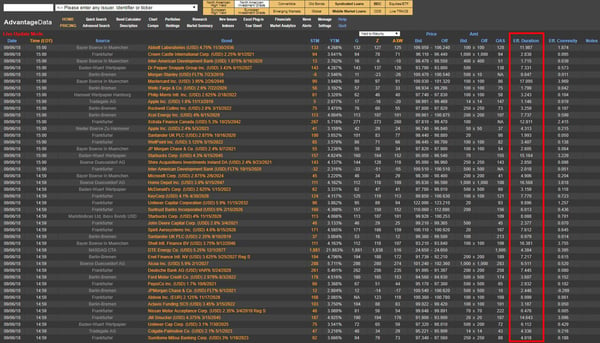Duration risk has been a popular theme around buy-side firms as they look to incorporate low duration bonds into model portfolios to reduce interest rate sensitivity and increase liquidity. Typical bond indexes have an average duration of 5-7 years; this will create large outflow of assets in the upcoming quarters and increase popularity among individual securities.
What is duration risk?
Duration is expressed as a number of years but is not simply a measure of time. Investopedia defines duration risk as “a measure of the sensitivity of the price -- the value of principal -- of a fixed-income investment to a change in interest rates.” [source]
Bond yields and prices have an inverse relationship; an increase in interest rates causes the price of the bond to fall. The duration tells us how great the fluctuation of a bonds price would be if interest rates were to change.
Using an example from the Financial Industry Regulatory Authority website, let’s say we have an investment grade corporate bond with a rating of BBB, Baa or similar, a 10-year maturity, a 3.5 percent coupon, and a duration of 8.4. This bond could lose 15 percent of its market value if interest rates were to increase 2 percent. Likewise, a similarly rated bond with a 30-year maturity, a 4.5 percent coupon, and a duration of 14.5 might experience a loss in value of 26 percent. The second bond responds to the increased interest rate more dramatically because its duration number is higher. [source]
What does this mean for me?
FINRA writes, “if you hold a bond to maturity, you can expect to receive the par (or face) value of the bond when your principal is repaid, unless the company goes bankrupt or otherwise fails to pay. If you sell before maturity, the price you receive will be affected by the prevailing interest rates and duration.” [source]
If you plan to hold a bond to maturity, then duration risk has little to no effect on you. If you sell your holding before maturity at a lower interest rate than when you purchased, you could potentially sell for a higher price. Conversely, selling at a time of higher interest rates would mean a lower price, and the significance of that price difference is determined by your bonds duration.
Duration risk can be used to source better deals on bonds, and aid in portfolio construction. Meaningful comparison of bonds and bond funds with different coupon rates and maturity dates is easy when exploiting duration. According to Investopedia, the expectation of rising interest rates would point investors to shorter-duration bonds, which are less affected by interest rate change.
AdvantageData has you covered
When a client logs into the AdvantageData workstation, they can view the effective duration along with pricing, yield, notes and other information – right on the first screen. ADI makes it easy to access the information you need quickly.

AdvantageData’s workstation gives you access to more than 529,400 U.S. and international corporate bonds. From over 1500 sources, our data provides more accurate pricing, descriptive data and analytics than any other provider.
With one of the largest searchable databases of syndicated loans, middle market loans and high yield/investment grade corporate bonds in the world, AdvantageData offers clients a greater scope of coverage, including off-the-run data which cannot be found anywhere else. Nobody covers the credit market better than AdvantageData.


.png)




